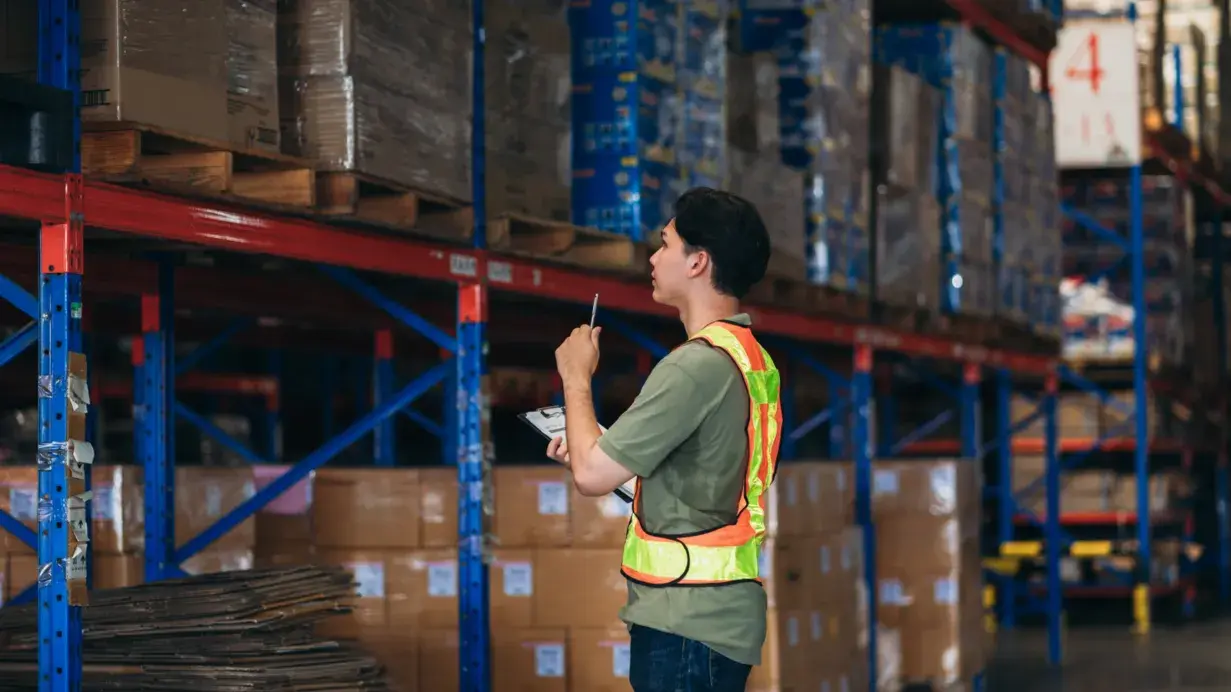Table of Contents
ToggleFTZ Inventory Control refers to the process of managing and monitoring goods within a Foreign Trade Zone (FTZ) to ensure compliance with regulations while optimizing costs and efficiency. It involves tracking the location, status, and value of inventory, adhering to U.S. Customs and Border Protection (CBP) requirements, and using advanced technology to streamline operations.
Proper control is not just about avoiding fines—it’s about unlocking the full potential of FTZs to reduce duties, streamline logistics, and improve overall supply chain performance.

Having spent decades in the third-party logistics and FTZ management industry, I’ve seen businesses transform when they embrace proper FTZ Inventory Control. At its core, this practice ensures that companies remain compliant with CBP regulations, avoiding fines and operational disruptions.
But there’s more to it than just compliance—it’s about efficiency. When inventory is well-tracked, businesses can reduce costs tied to duties, taxes, and tariffs.
Imagine a scenario where a company uses outdated systems to manage inventory. Mistakes, delays, and misreported data can quickly lead to penalties.
On the other hand, a robust FTZ Inventory Control system can automate compliance tasks, saving time and reducing errors. For businesses relying on precise inventory flows, like automotive or technology firms, this control isn’t optional; it’s essential.
Managing inventory within an FTZ is no small feat. I’ve worked with businesses that initially struggled with regulatory compliance, especially when faced with complex reporting requirements.
Keeping meticulous records for merchandise location, zone status, and transactional movements is mandatory. Failing to do so can lead to audits, fines, or even the loss of FTZ privileges.
Additionally, demand fluctuations complicate inventory management. For example, in industries with seasonal peaks, aligning inventory levels to demand becomes a challenge.
Without effective tools, companies risk overstocking or understocking, which can both lead to financial losses. These challenges make it clear that outdated methods, like manual spreadsheets, are no longer viable in today’s fast-paced logistics environment.
Technology has revolutionized FTZ management, and I’ve witnessed its transformative impact firsthand. At Tri-Link FTZ, we’ve implemented cutting-edge systems that seamlessly integrate with CBP’s Automated Commercial Environment (ACE).
This integration eliminates the need for duplicate data entry, saving time and ensuring accuracy. Modern FTZ software tracks key details like merchandise location, value, and movement in real-time.
Advanced systems also send proactive alerts, notifying businesses of upcoming compliance deadlines or inventory discrepancies. These features empower companies to stay ahead of potential issues, ensuring smooth operations and uninterrupted savings.
Another major advantage is data analytics. FTZ Inventory Control software doesn’t just track inventory; it provides insights.
Businesses can analyze trends, optimize inventory levels, and identify cost-saving opportunities. For instance, one of our clients used analytics to reduce storage costs by 20% simply by adjusting reorder points based on seasonal demand patterns. To read more click here.

Based on our 35 years of experience, I can confidently say that maintaining accurate inventory records is the cornerstone of successful FTZ operations. It starts with assigning unique zone identifiers for all merchandise.
This practice ensures that every item is traceable at all times. Regular audits are another critical component.
Conducting periodic checks helps businesses identify discrepancies before they escalate. Coupled with robust FTZ software, these audits become less cumbersome and more effective.
Automated systems can even generate reconciliation reports, a task that used to consume hours of manual labor. Lastly, training is key.
Even the most advanced software is only as effective as the people using it. At Tri-Link FTZ, we emphasize hands-on training to ensure our clients’ teams are well-equipped to handle inventory control tasks confidently.
Customs compliance is non-negotiable for businesses operating in an FTZ. CBP mandates that all imports and exports be reported accurately, and discrepancies can result in severe penalties.
I’ve seen businesses struggle with this, especially when they rely on manual processes. By leveraging FTZ Inventory Control software, companies can automate reporting and ensure that customs data is always up-to-date.
These systems also integrate with CBP’s ACE, automatically updating details like HTSUS codes, currency conversion rates, and LACEY Act declarations. This seamless integration not only ensures compliance but also builds trust with regulatory agencies, which is invaluable during audits.
Specialized technologies designed for FTZ operations go beyond basic inventory management. At Tri-Link FTZ, we’ve partnered with providers to implement ERP systems tailored to the unique needs of our clients.
These systems handle everything from tracking shipments to generating detailed analytics reports. One standout feature of modern FTZ software is its ability to adapt.
For example, if a company imports high-value goods, the system can prioritize their storage and movement, reducing potential risks. Similarly, AI-powered forecasting tools can predict demand fluctuations, helping businesses maintain optimal inventory levels.
The benefits extend beyond compliance. Advanced systems simplify complex tasks, like preparing annual reconciliation reports.
For one client, adopting such a system reduced their administrative workload by 30%, freeing up resources for strategic initiatives.

Balancing inventory levels in an FTZ is both an art and a science. Too much inventory ties up capital and increases storage costs, while too little can disrupt operations.
This is where demand forecasting and just-in-time inventory strategies come into play. Using analytics, businesses can predict seasonal trends and adjust their inventory accordingly.
One client in the retail industry used these insights to reduce stockouts during the holiday season, resulting in a 15% increase in sales. Additionally, outsourcing outbound logistics to third-party logistics (3PL) providers can be a game-changer.
At Tri-Link FTZ, we’ve helped clients optimize their inventory flow by coordinating with 3PLs. This approach not only reduces storage costs but also ensures timely deliveries to end-users. To read more click here.
The financial benefits of effective FTZ Inventory Control are undeniable. By automating processes, companies can significantly reduce administrative costs.
One of our clients saved over $100,000 annually simply by switching from manual to automated reporting. FTZs also offer substantial duty savings.
Goods stored within a zone are exempt from duties until they leave the FTZ for domestic consumption. Businesses can defer or even eliminate these costs by re-exporting goods.
Moreover, advanced analytics allow companies to identify inefficiencies and address them proactively. For example, analyzing transportation costs led one client to consolidate shipments, saving them 18% on logistics expenses.
The differences between FTZ and non-FTZ inventory control practices are stark. In a traditional warehouse, inventory management focuses primarily on operational efficiency.
However, in an FTZ, compliance takes center stage. FTZs require meticulous recordkeeping and adherence to strict regulations.
This means that businesses must invest in specialized systems and processes. While this may seem daunting, the rewards—duty savings, operational flexibility, and improved supply chain resilience—far outweigh the challenges.
For businesses considering a transition to FTZ operations, it’s essential to understand these differences. At Tri-Link FTZ, we guide our clients through this process, ensuring a smooth and successful transition.

Building an efficient FTZ Inventory Control system starts with a thorough needs assessment. Businesses must evaluate their inventory requirements, compliance obligations, and operational goals.
The next step is selecting the right technology. At Tri-Link FTZ, we recommend systems that integrate seamlessly with CBP ACE and offer advanced analytics capabilities.
Implementing these systems requires careful planning, from setting up workflows to training staff. Continuous improvement is key.
Regularly reviewing processes and leveraging analytics ensures that businesses remain agile and efficient. With the right approach, FTZ Inventory Control becomes a strategic asset, driving growth and profitability.
With over 35 years of experience, Tri-Link FTZ is uniquely positioned to help businesses optimize their FTZ operations. From implementing advanced technologies to providing hands-on training, we’ve helped countless clients unlock the full potential of FTZs.
If you’re ready to take your FTZ Inventory Control to the next level, schedule a consultation with our experts. Together, we can build a solution tailored to your unique needs, ensuring compliance, efficiency, and success.
Share this article
We have other resources available upon request as well as one-on-one support and personalized answers, just like our services.
Simply contact us anytime and we’ll get back to you to answer your questions and provide meaningful answers that show you how Tri-Link supports your logistics, reduces costs, and accelerates efficiency.
Tri-Link delivers exceptional FTZ and 3PL services tailored to your global trade needs.
Our solutions combine innovation, quality, and efficiency to exceed your expectations and meet your specific requirements.